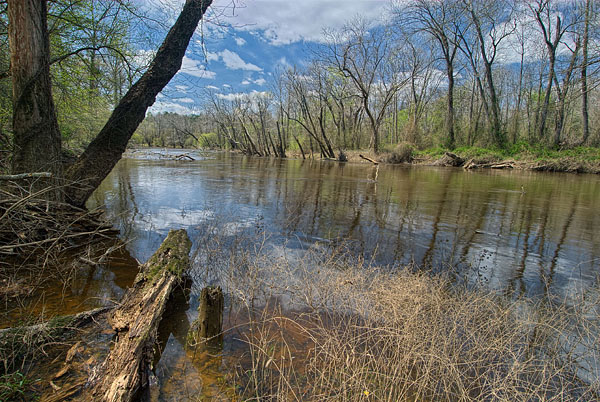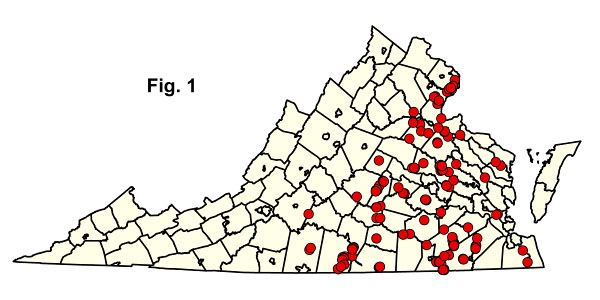

Virginia Department of Conservation and RecreationAn official website of the Commonwealth of Virginia Here's how you knowAn official websiteHere's how you know

Virginia Department of Conservation and RecreationAn official website of the Commonwealth of Virginia Here's how you knowAn official websiteHere's how you know
 Department of Conservation and Recreation
Department of Conservation and Recreation
 Table of Contents
Table of ContentsCoastal Plain / Piedmont Bottomland Forests
This is a diverse group of temporarily flooded to seasonally flooded forests occupying floodplains and river terraces of the Coastal Plain and outer Piedmont . It includes all of the relatively well-drained forests of levees and higher terraces, along with wetter swamps that are not dominated by bald cypress (Taxodium distichum) and tupelos (Nyssa spp.). In the larger Coastal Plain river bottoms, microtopographic heterogeneity is very high, and it can be difficult to determine flooding frequency and duration without repeated observations and study. Communities in this large group tend to sort themselves out along intersecting gradients that include relative elevation above stream level, hydroperiod, soil drainage, soil texture, and soil fertility.
Characteristic tree species vary with stream order, soil type, flooding regime, and successional status. High, infrequently flooded terraces along brownwater rivers (e.g., the Nottoway) of southeastern Virginia support swamp chestnut oak (Quercus michauxii), cherrybark oak (Quercus pagoda), shagbark hickory (Carya ovata), and sweetgum Liquidambar styraciflua), with an understory of deciduous holly (Ilex decidua), American hornbeam (Carpinus caroliniana ssp. caroliniana and ssp. virginiana), Elliott's blueberry (Vaccinium elliottii), parsley hawthorn (Crataegus marshallii), and other species of relatively well-drained soils. In the same drainages, low terraces or swales on higher terraces support forests of green ash (Fraxinus pennsylvanica), water hickory (Carya aquatica), overcup oak (Quercus lyrata), and laurel oak (Quercus laurifolia), often with a minor component of bald cypress (Taxodium distichum) and water tupelo (Nyssa aquatica). These forests are usually flooded during the winter and early spring but exposed during much of the growing season. Their understory is typically open, with sedges and grasses (especially Carex typhina, Carex louisianica, and Leersia lenticularis) dominant in the herb layer. Analogous communities of the Piedmont and northern Coastal Plain are similar but with overstory dominance by willow oak (Quercus phellos) and pin oak (Quercus palustris).

The wettest swamps of the northern Coastal Plain are usually co-dominated by green ash and red maple (Acer rubrum), with large clones of hydrophytic forbs such as lizard's-tail (Saururus cernuus) in the herb layer. Herb layers of swamp forests contain many species well adapted to fluctuating water levels and often have distinctly seasonal aspects related to inundation and draw-down cycles. The early-season aspect of more deeply flooded microhabitats may be completely dominated by emergent aquatics such as eastern mannagrass (Glyceria septentrionalis), swamp dock (Rumex verticillatus), and Virginia blue flag (Iris virginica). Late-season draw-down zones are often lush with common wood reedgrass (Cinna arundinacea) and forbs such as lizard's tail, false nettle (Boehmeria cylindrica), small beggar's-ticks (Bidens discoidea), winged monkeyflower (Mimulus alatus), mad-dog skullcap (Scutellaria lateriflora), and dense-flowered smartweed (Persicaria densiflora). Such swamps are particularly important conservators of diverse animal populations because of their landscape continuity, abundance of water, and multifaceted food and habitat resources. These communities typically support an array of nesting birds, mammals, invertebrates, reptiles, and amphibians.
On sandy levees and well-drained terraces of inner Coastal Plain and southern Piedmont rivers, stands often lack a significant oak component and contain mixed overstories of sycamore (Platanus occidentalis), sweetgum (Liquidambar styraciflua), hackberries (Celtis occidentalis and Celtis laevigata), American elm (Ulmus americana), river birch (Betula nigra), and green ash. A rich floodplain forest containing American beech (Fagus grandifolia), bitternut hickory (Carya cordiformis), Shumard oak (Quercus shumardii), swamp chestnut oak, and a diverse assortment of nutrient-demanding herbs has been documented on floodplains of the Pamunkey, Mattaponi, and Rappahannock Rivers in east-central Virginia. On small stream bottoms, where alluvial landforms and habitat conditions occur at very small scales, trees typical of both levees and swamps may occur in mixed stands. On well-drained small stream bottoms, tulip-tree (Liriodendron tulipifera) is often important. Understory and herbaceous composition is highly variable with geography and site conditions.
References: Crouch (1990), Fleming (2002a), Fleming and Moorhead (1998), Frost and Musselman (1987), Glascock and Ware (1979), McCoy and Fleming (2000), Parker and Wyatt (1975), Parsons and Ware (1982), Rheinhardt et al . (2000), Walton et al. (2001).
Click here for more photos of this ecological community group.
 © DCR-DNH, Gary P. Fleming.
© DCR-DNH, Gary P. Fleming.

 Download a spreadsheet of compositional summary statistics (Excel) for each of the community types listed below.
Download a spreadsheet of compositional summary statistics (Excel) for each of the community types listed below.

